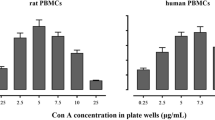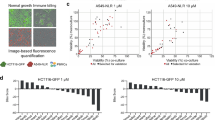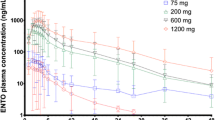ABSTRACT
Purpose
Everolimus is an immunosuppressant that blocks growth factor-mediated proliferation of hematopoietic cells by targeting the mammalian target of rapamycin (mTOR). Sorafenib is a multikinase inhibitor that inhibits cell proliferation by arresting cells in the G0-G1 phase of the cell cycle. These agents are under investigation as combination therapy for various cancers. Because the two drugs individually inhibit lymphocyte proliferation, this study examined the effects of everolimus and sorafenib on lymphocyte proliferation in order to anticipate possible immunosuppression.
Methods
Inhibition of lymphocyte proliferation was evaluated ex vivo over a range of concentrations of these drugs, alone and in combination. Data analysis, using a population approach to characterize interactions, employed the Ariens noncompetitive interaction model, which was modified to accommodate interactions of the two drugs.
Results
Everolimus alone caused partial inhibition of lymphocyte proliferation, with a mean IC50 of 4.5 nM for females and 10.5 nM in males. Sorafenib alone caused complete inhibition, with a mean IC50 of 11.4 μM and no difference between genders.
Conclusion
The population estimate for the interaction term was greater than 1, suggesting that the two drugs exert slight antagonism in terms of inhibition of lymphocyte proliferation.






Similar content being viewed by others
REFERENCES
Schuler W, Sedrani R, Cottens S, Haberlin B, Schulz M, Schuurman HJ, et al. SDZ RAD, a new rapamycin derivative: pharmacological properties in vitro and in vivo. Transplantation. 1997;64(1):36–42. Epub 1997/07/15.
Bohler T, Waiser J, Budde K, Lichter S, Jauho A, Fritsche L, et al. The in vivo effect of rapamycin derivative SDZ RAD on lymphocyte proliferation. Transplant Proc. 1998;30(5):2195–7. Epub 1998/09/02.
Atkins MB, Yasothan U, Kirkpatrick P. Everolimus. Nat Rev Drug Discov. 2009;8(7):535–6. Epub 2009/07/02.
Houben R, Voigt H, Noelke C, Hofmeister V, Becker JC, Schrama D. MAPK-independent impairment of T-cell responses by the multikinase inhibitor sorafenib. Mol Cancer Ther. 2009;8(2):433–40. Epub 2009/02/05.
Zhao W, Gu YH, Song R, Qu BQ, Xu Q. Sorafenib inhibits activation of human peripheral blood T cells by targeting LCK phosphorylation. Leukemia. 2008;22(6):1226–33. Epub 2008/03/14.
Piekoszewski W, Chow FS, Jusko WJ. Inhibition of phytohaemagglutinin-induced lymphocyte proliferation by immunosuppressive drugs: use of whole blood culture. Immunopharmacol Immunotoxicol. 1994;16(3):389–401. Epub 1994/08/01.
Ariens EJ, Van Rossum JM, Simonis AM. Affinity, intrinsic activity and drug interactions. Pharmacol Rev. 1957;9(2):218–36. Epub 1957/06/01.
Chakraborty A, Jusko WJ. Pharmacodynamic interaction of recombinant human interleukin-10 and prednisolone using in vitro whole blood lymphocyte proliferation. J Pharm Sci. 2002;91(5):1334–42. Epub 2002/04/27.
Ferron GM, Pyszczynski NA, Jusko WJ. Gender-related assessment of cyclosporine/prednisolone/sirolimus interactions in three human lymphocyte proliferation assays. Transplantation. 1998;65(9):1203–9. Epub 1998/05/29.
Kamal MA, Jusko WJ. Interactions of prednisolone and other immunosuppressants used in dual treatment of systemic lupus erythematosus in lymphocyte proliferation assays. J Clin Pharmacol. 2004;44(9):1034–45. Epub 2004/08/20.
Lee MJ, Pyszczynski N, Jusko WJ. Combined inhibition effects of tacrolimus and methylprednisolone on in vitro human lymphocyte proliferation. Immunopharmacol Immunotoxicol. 1995;17(2):335–45. Epub 1995/05/01.
Meno-Tetang GM, Hon YY, Jusko WJ. Synergistic interaction between dehydroepiandrosterone and prednisolone in the inhibition of rat lymphocyte proliferation. Immunopharmacol Immunotoxicol. 1996;18(3):443–56. Epub 1996/08/01.
Ramakrishnan R, Jusko WJ. Interactions of aspirin and salicylic acid with prednisolone for inhibition of lymphocyte proliferation. Int Immunopharmacol. 2001;1(11):2035–42. Epub 2001/10/19.
Ferron GM, Jusko WJ. Species- and gender-related differences in cyclosporine/prednisolone/sirolimus interactions in whole blood lymphocyte proliferation assays. J Pharmacol Exp Ther. 1998;286(1):191–200. Epub 1998/07/10.
Beal SL. NONMEM users guide Ellicott City: Icon Development Solutions; 2006.
Nashan B. Early clinical experience with a novel rapamycin derivative. Ther Drug Monit. 2002;24(1):53–8. Epub 2002/01/24.
Hommes DW, Peppelenbosch MP, van Deventer SJ. Mitogen activated protein (MAP) kinase signal transduction pathways and novel anti-inflammatory targets. Gut. 2003;52(1):144–51. Epub 2002/12/13.
Gangadhar TC, Cohen EE, Wu K, Janisch L, Geary D, Kocherginsky M, et al. Two drug interaction studies of sirolimus in combination with sorafenib or sunitinib in patients with advanced malignancies. Clin Cancer Res. 2011;17(7):1956–63. Epub 2011/03/31.
Harzstark AL, Small EJ, Weinberg VK, Sun J, Ryan CJ, Lin AM, et al. A phase 1 study of everolimus and sorafenib for metastatic clear cell renal cell carcinoma. Cancer. 2011;117(18):4194–200. Epub 2011/03/10.
Christians U, Strom T, Zhang YL, Steudel W, Schmitz V, Trump S, et al. Active drug transport of immunosuppressants: new insights for pharmacokinetics and pharmacodynamics. Ther Drug Monit. 2006;28(1):39–44. Epub 2006/01/19.
Crowe A, Lemaire M. In vitro and in situ absorption of SDZ-RAD using a human intestinal cell line (Caco-2) and a single pass perfusion model in rats: comparison with rapamycin. Pharm Res. 1998;15(11):1666–72. Epub 1998/12/02.
Strumberg D, Clark JW, Awada A, Moore MJ, Richly H, Hendlisz A, et al. Safety, pharmacokinetics, and preliminary antitumor activity of sorafenib: a review of four phase I trials in patients with advanced refractory solid tumors. Oncologist. 2007;12(4):426–37. Epub 2007/05/02.
Garnock-Jones KP, Keating GM. Everolimus: in advanced renal cell carcinoma. Drugs. 2009;69(15):2115–24. Epub 2009/10/02.
ACKNOWLEDGMENTS AND DISCLOSURES
This work was support by a grant from the UB Center for Translational Research and NIH Grant No. GM57980.
Author information
Authors and Affiliations
Corresponding author
Rights and permissions
About this article
Cite this article
Pawaskar, D.K., Straubinger, R.M., Fetterly, G.J. et al. Interactions of Everolimus and Sorafenib in Whole Blood Lymphocyte Proliferation. Pharm Res 30, 707–713 (2013). https://doi.org/10.1007/s11095-012-0909-z
Received:
Accepted:
Published:
Issue Date:
DOI: https://doi.org/10.1007/s11095-012-0909-z




